
|
Mother Pelican
A Journal of Sustainable Human Development
Vol. 8, No. 2, February 2012
Luis T. Gutiérrez, Editor
|
|
|
|

|
|
|
|
Long-Term Strategies for Sustainable Energy
|
|
SUMMARY & OUTLINE
This entire page is being reworked and is work in progress. The plan is to build a "one page synthesis" of strategies for the transition to clean energy.
1. Primacy of Integral Human Development
2. Joint Integrity of Humanity and the Human Habitat
3. Mitigation Strategies for Sustainable Human Development
4. Adaptation Strategies for Sustainable Human Development
5. Solidarity, Subsidiarity, Sustainability, and Nonviolence
6. Non-Renewable & Renewable Energy Resources
7. Integrated Strategy for the Transition to Clean Energy
8. Variations of the Integrated Transition Strategy
9. Strategic Data Sources & Global Transition Megatrends
Reach out about climate
Editorial, Nature, 5 January 2012
"Where political leadership on climate change is lacking,
scientists must be prepared to stick their heads above the parapet."
|
|
APPENDIX: ANALYSIS & SYNTHESIS OF LONG-TERM TRANSITION DYNAMICS
Methods for analysis of long-term transition strategies include system dynamics and agent-based simulation. Software is readily available to do the number crunching. For example, see these
simulations derived from this causal-loop diagram of processes that generate economic growth and collapse.
At the strategic level, simulations provide a way to build scenarios for analysis and discussion pursuant to policy recommendations. It should be stressed that this kind of exercise has nothing to do with prediction of specific events. Models are usually built on soft data in order to include the decision functions that really matter. But these are not "problem-solving" models that produce "solutions" ready to be implemented. They are, however, instrumental for analysis and synthesis of policy issues when frequently revised as conditions change.
NOTE ON THE EVOLUTION FROM SDSIM 1.5 TO SDSIM 2.0
Due to the rapid succession of events related to sustainable development worldwide, the entire SDSIM simulation project is under review. It has been determined that the basic structure of the Version 1 series must be reworked to focus on the two sets of feedback loops that matter the most: human development (including gender equality) and the replacement of fossil fuels by clean energy. This will take time, and therefore there will be a hiatus between SDSIM 1.5 and the next series of simulations to start with SDSIM 2.0.
During the SDSIM model reformulation, this supplement will serve to keep track of significant social, economic, and technical developments related to clean energy. The latest SDSIM 1.5 documentation is available here, and the web-based version of the simulation model is available in the FORIO server. The basic architecture for SDSIM 2.0 is shaping up as described in Section 7.
|
NOTE: For the list of links to online references reviewed in previous issues, click here
|
|
1. Primacy of Integral Human Development
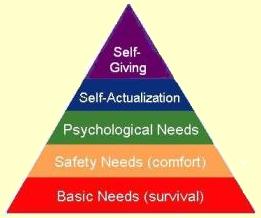
Maslow's Hierarchy of Human Needs
Adapted from The Cell
|
As a matter of principle, any strategy for the transition to clean energy must recognize integral human development as the most fundamental requirement to guide both public and private initiatives. Integral human development builds on respect for human rights and diligence on human duties, both individually and institutionally. A fundamental document is The Universal Declaration of Human Rights, approved by the United Nations General Assembly on 10 December 1948.
Hierarchy of Human Needs
Abraham Maslow (USA, 1908-1970) created the "hierarchy of human needs" in the 1940s. Maslow's model explicitly takes into account the physiological, safety, emotional, love/belonging, esteem/self-esteem, and self-actualization stages of integral human development. The hierarchy of human needs is usually represented as a pyramid, with the most basic needs at the bottom and the socialization needs at the top. There are many variations of the pyramid: one is shown to the right and others can be easily found. Going upward, the progression for each human being is to satisfy (1) the basic physical and physiological needs, (2) the need for safety and security, (3) the need psychological well-being, (4) the need for self-actualization (self-esteem, social responsibility), and (5) self-giving to others, or at least the desire to seek the common good in conjunction with legitimate self-interest. For further discussion of Maslow's "levels of human development" - and other models of human development - the reader is referred to the May 2010 issue of Mother Pelican. Attaining a culture of solidarity and sustainability is practically impossible under level 3, and generally requires level 4.
Integral Human Development (IHD)
The IHD concept envisions a world where all people are able to live to their full potential, meeting their basic physical needs sustainably,
while living with dignity in a just and peaceful society. It is based on "right relationships". Three key elements of IHD include:
- Holistic: Integral Human Development promotes the good of every person and the whole person; it is economic, social, political, cultural, ecological and spiritual. It also promotes the integrity of creation.
- Solidarity: Integral Human Development promotes the rights and responsibilities of each person and of every person to one another.
- Justice and Peace: Integral Human Development promotes a just and peaceful society that respects the dignity of every person.
Source: Catholic Relief Services, 2008
|
In other words, enabling people "to live to their full potential" requires, beyond meeting basic physical needs, access to educational and job opportunities as well as freedom for each person follow their "vocation" in life under conditions of human solidarity, social justice, and ecological sustainability.
An extensive transdisciplinary review of the literature on human development has been done and documented. Click here to review this material. The bottom line is that gender equality, and gender balance in roles of responsibility and authority, are essential for
- A civilized transition from fossil fuels to clean energy
- A civilized transition from consumerism to sustainability
- Further sustainable advances in integral human development
RECENT:
EDITOR'S NOTE: A synthesis of this material as it pertains to the energy-economic-ecological crisis is taking shape and is reported in Section 7 of this page.
|
2. Joint Integrity of Humanity and the Human Habitat
|
Human development cannot happen in a vacuum. Therefore, maintaining the integrity of the human habitat is essential for sustainable human development. A fundamental document is The Earth Charter, approved by the Earth Charter Commission 29 June 2000 after 5 years of preparation and worldwide consultation.
Humanity and the Human Habitat
|
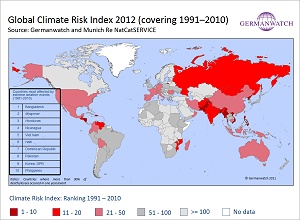
Global Climate Risk Index 2011
[click on map to enlarge]
|
As in previous years, the Global Climate Risk Index 2012 analyses to what extent countries have been affected by the impacts of weather-related loss events (storms, floods, heat waves etc.). The most recent available data from 2010 as well as for the period 1991-2010 were taken into account. Most affected countries in 2010 were Pakistan, Guatemala, Colombia and Russia. For the period 1991 to 2010, Bangladesh, Myanmar and Honduras rank highest.
This year's analysis underlines that less developed countries are generally more affected than industrialised countries, according to the Climate Risk Index. With regard to future climate change, the Climate Risk Index can serve as a warning signal indicating past vulnerability which may further increase in regions where extreme events will become more frequent or more severe through climate change. While some vulnerable developing countries are frequently hit by extreme events, there are also some where such disasters are a rarity.
In Cancún at COP16 an Adaptation Framework was adopted in order to secure an institutional and financial support for vulnerable countries. The climate summit in Durban (COP17) will have to make substantial steps in order to further put into action the initiated processes and to scale-up adaptation.
KEY MESSAGES
According to the Germanwatch Global Climate Risk Index, Bangladesh, Myanmar, and Honduras were the countries most affected by extreme weather events from 1991 to 2010;
All of the ten most affected countries (1991-2010) were developing countries in the low-income or lower-middle income country group;
In total, more than 710,000 people died as a direct consequence of more than 14,000 extreme weather events, and losses of more than 2.3 trillion USD (in PPP) occurred from 1991 to 2010 (USD 1.5 trillion overall losses in original values);
In 2010, the ranking of the most affected countries is led by Pakistan, Guatemala, Colombia, Russia and Honduras;
In the case of the Russian heatwave some scientists see a high probability that without climate change this event would not have occurred;
Loss and damage from anthropogenic climate change is expected to further increase; therefore, the current lack of ambition in mitigation putting the world on a path of 4 to 5°C increase in average temperature would result in a large-scale experiment unprecedented in the history of mankind;
Many developing countries are already taking action to prepare for climate-related disasters and to promote as well as implement adaptation. However, adequate financial and institutional support provided by developed countries is required to further increase disaster preparedness and resilience of poor countries. Operationalising the Green Climate Fund at COP17 in Durban could be one important step to build up long-term support;
Through the adoption of the Cancún Adaptation Framework (CAF) at COP16, an important step was made by Parties to the UNFCCC for a more ambitious and coherent approach to adaptation. The CAF also contained the decision on a work programme on loss and damage from the adverse impacts of climate change. For COP17 in Durban, it is crucial to define the concrete next steps with a view to reaching a more comprehensive and ambitious decision at COP18.
|
That humans are inflicting violence on the human habitat is by now beyond dispute, and it is time for climate change skeptics to reconsider. In fact, a recent study by the Berkeley Earth Surface Temperature Project is hopefully putting the "Climategate" episode to rest:
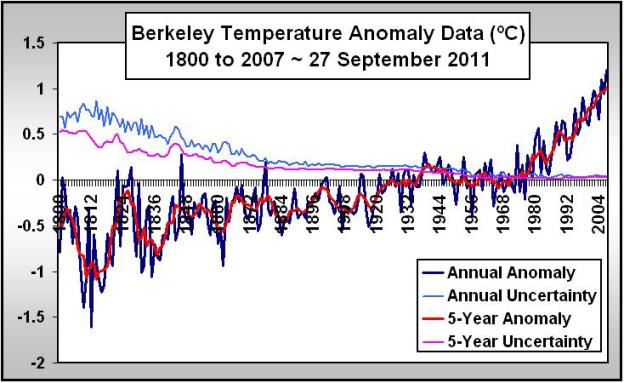
Data Source: Berkeley Earth Surface Temperature Study, 27 September 2011
In the vertical scale, 0ºC corresponds to the 1950-1980 mean land surface temperature
Results are based on 37633 time series with 14502771 data points
|
The Berkeley results confirm previous studies by NASA, NOAA, and the Hadley Climate Research Unit at the University of East Anglia, as shown by comparative plotting of the four sets of data:
|
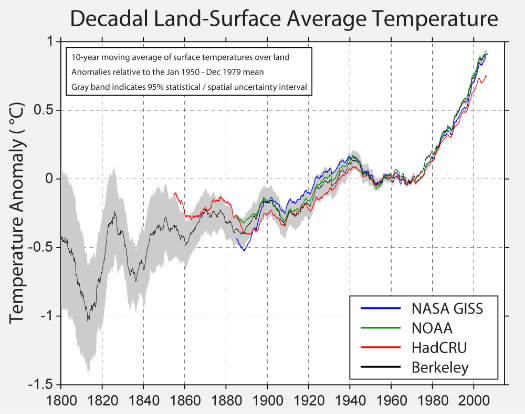
Source: Berkeley Earth Surface Temperature Analysis, 20 October 2011
10-year moving average of surface temperatures over land
Anomalies relative to the January 1950 - December 1979 mean
Gray band indicates 95% statistical / spatial uncertainty interval
REPRINTED WITH PERMISSION
Excerpt from A New Assessment of Global Warming: "The most important indicator of global warming, by far, is the land and sea surface temperature record. This has been criticized in several ways, including the choice of stations and the methods for correcting systematic errors. The Berkeley Earth Surface Temperature study sets out to to do a new analysis of the surface temperature record in a rigorous manner that addresses this criticism. We are using over 39,000 unique stations, which is more than five times the 7,280 stations found in the Global Historical Climatology Network Monthly data set (GHCN-M) that has served as the focus of many climate studies. Our aim is to resolve current criticism of the former temperature analyses, and to prepare an open record that will allow rapid response to further criticism or suggestions. Our results include not only our best estimate for the global temperature change, but estimates of the uncertainties in the record."
|
REVIEWS
New study shows Climategate scientists were right
By Bob McDonald, CBC News, 21 October 2011
Courtesy Quirks & Quarks, Copyright CBC Radio
Another independent study, this time from the United States, has shown that the climate scientists accused of the so-called "Climategate" affair were, in fact, right about the warming of the Earth.
The Berkeley Earth study was an independent scientific group, including this year's Nobel Physics Prize winner Saul Perlmutter, that used different and more detailed methods to analyze past climate records. But they came to the same conclusion that scientists at the University of East Anglia in England, as well as those at NOAA and NASA, have reached: that the climate over land has been on the rise since at least 1800, the beginning of the Industrial Revolution.
The intent of the study was to quell the voices of climate skeptics, who have charged that scientific methods were flawed and data have been manipulated or skewed to support climate warming. One of the biggest criticisms of past studies is that many weather recording stations are in urban areas, where heat from cities would give false readings. This study, using data from about 40,000 weather stations around the world, showed that while cities do indeed create a heat island effect, they do not affect the overall climate of the planet, because cities only cover about one percent of the land.
The report also showed how cooling periods, which are also used by skeptics to show warming is not happening, are caused by oscillating ocean currents, which can lower average temperatures for years; but then the trend continues its long-term upward climb. It's all part of the process of a changing climate. The scientists in the study have also made all their data and methods available for scrutiny online, to show total transparency.
This is sweet news for scientists at the Climate Research Unit at East Anglia, who had emails hacked and were falsely accused of manipulating data. More importantly, the report will provide ammunition for politicians preparing for the next UN Climate Summit in South Africa next month.
At the same time, a large consortium of more than 200 corporations from around the world, called the 2°C Challenge, is calling for government action on climate change. The business community realizes that there are considerable costs involved if nothing is done to curb climate change, and profits to be made if companies "go green."
In recent years, these annual UN summits have been deadlocked by countries, including Canada, that often claim the climate science is uncertain, and that the cost of change would hurt the economy. This study and the growing consensus of the corporate community (outside the fossil fuel industry) show that those statements are no longer valid excuses for inaction.
The scientists have done their work and stand united on their results. The business community agrees. Now it's time for the politicians to get on with doing something about it.
|
Another recent report:
Global Temperatures in September Were Eighth Warmest on Record
National Oceanic and Atmospheric Administration, October 13, 2011
Excerpt: "The Earth experienced its eighth warmest September since record keeping began in 1880. The combined global land and ocean average surface temperature was 59.95ºF, which is 0.95ºF above the 20th century average of 59.0ºF. Separately, the global land surface temperature was 1.57ºF above the 20th century average of 53.6ºF, making this the fourth warmest September on record. The September global ocean surface temperature was 0.72ºF above the 20th century average of 61.1ºF, making it the 14th warmest September on record. The annual minimum Arctic sea ice extent was reached on September 9 and ranked as the second smallest extent since satellite records began in 1979."
|
Another assessment of the current situation:
Our sustainable Earth
Raymond L. Orbach, Professor and Director, Energy Institute, University of Texas at Austin
IOP Science, October 2011
Abstract: "Recent evidence demonstrates that the Earth has been warming monotonically since 1980.
Transient to equilibrium temperature changes take centuries to develop, as oceans are slow to
respond to atmospheric temperature changes. Atmospheric CO2 concentrations, from ice core
and observatory measurements, display consistent increases from historical averages,
beginning in about 1880, and can be associated with the industrial revolution. The climactic
consequences of this human dominated increase in atmospheric CO2 define a geologic epoch
that has been termed the ‘Anthropocene.’ The issue is whether this is a short term, relatively
minor change in global climate, or an extreme deviation that lasts for thousands of years. Eight
‘myths’ that posit the former are examined in light of known data. The analysis strongly
suggests the latter. In order to stabilize global temperatures, sharp reductions in CO2
emissions are required: an 80% reduction beginning in 2050. Two examples of economically
sustainable CO2 emission reduction demonstrate that technological innovation has the
potential to maintain our standard of living while stabilizing global temperatures."
|
Another assessment of the current outlook:
Warming Could Exceed Safe Levels in This Lifetime
Nina Chestney, Reuters, 24 October 2011
"Global temperature rise could exceed "safe" levels of two degrees Celsius in some parts of the world in many of our lifetimes if greenhouse gas emissions continue to increase, warned two research papers published by academics at the English universities of Reading and Oxford, the UK's Met Office Hadley Center and the Victoria University of Wellington, New Zealand in the journal "Nature." Large parts of Eurasia, North Africa and Canada could potentially experience individual five-year average temperatures that exceed the 2 degree Celsius threshold by 2030. The study found that most of the world's land surface is very likely to experience five-year average temperatures that exceed 2 degrees above pre-industrial levels by 2060. If emissions are substantially lowered, the two degree threshold might be delayed by up to several decades, it added. However, even if global temperature rises are kept under two degrees by aggressive emissions cuts, some regions will still not avoid warming and the likelihood of extreme events such as heatwaves is still high in even a marginally warmer world."
|
Latest assessment on global warming by the WMO:
World Meteorological Organization Says 2011 One of Hottest Years on Record
Jon Herskovitz, Reuters, 30 November 2011
Excerpt: "The world is getting hotter, with 2011 one of the warmest years on record, and humans are to blame, according to a report by the World Meteorological Organization. The WMO, part of the United Nations, said the warmest 13 years of average global temperatures have all occurred in the 15 years since 1997. That has contributed to extreme weather conditions that amplify floods, droughts and other extreme weather patterns. Global temperatures in 2011 are currently the tenth highest on record and are higher than any previous year with a La Nina event, which has a relative cooling influence. The WMO report said the extent of Arctic sea ice in 2011 was the second lowest on record, and its volume was the lowest. It said the build-up of greenhouse gases put the world at a tipping point of irreversible changes in ecosystems."
|
Yale opinion poll about energy and climate issues in the USA:
Yale Releases New Poll on Energy and Climate Change
Yale Project on Climate Change Communication, 21 November 2011
Excerpt: "A new poll, the “Public Support for Climate & Energy Policies” document by the Yale Project on Climate Change Communication, finds that 90% of Americans polled saying development of clean energy sources should be a priority but 54 percent of Americans oppose subsidies to the ethanol industry to make fuel from corn. 70 percent of Americans say global warming should be a very high (12%), high (25%), or medium (33%) priority for the president and Congress and 54% say a candidate’s views on global warming would be important in determining their vote. 65 percent of Americans support a revenue neutral carbon tax that would “help create jobs and decrease pollution.” In terms of action, 85% of Americans said protecting the environment improves economic growth and/or provides new jobs, and 66% said the U.S. should undertake large or medium-scale efforts to reduce the effects of global warming. And 69% of Americans opposed federal subsidies to the fossil fuel industry."
|
Another scientific analysis of Arctic warming:
Arctic has taken a turn for the warmer: Scientists see pervasive and permanent changes in the last five years
Janet Raloff, Science, 2 December 2011
Excerpt: "The northern polar region’s climate has materially changed over the past five years, a team of 121 scientists from 14 nations concludes in a December 1 Arctic report card. Compared with 2006 and earlier, they note, the Arctic is warmer and less icy. Sufficient observational data now exist “to indicate a shift in the Arctic Ocean system since 2006,” says Jacqueline Richter-Menge of the U.S. Army’s Cold Regions Research and Engineering Laboratory in Hanover, N.H., a coeditor of the new analysis. “This shift is characterized by the persistent decline in the thickness and summer extent of sea-ice cover and by a warmer, less salty upper ocean.” The report’s big take-home message, she says: “These changes represent a persistent condition” — with consequences far beyond the Arctic."
Arctic Report Card:
Update for 2011
NOAA
Tracking recent environmental changes, with 23 essays on different aspects of the environment, by a team of 112 international authors, and independently peer-reviewed by the Arctic Monitoring and Assessment Programme of the Arctic Council. For more information and a PDF of the entire report click here.
|
REPORT ON THE POLITICS OF CLIMATE CHANGE
Durban Talks Open the Door to a Future Global Legal Agreement,
But Produce No Immediate Strengthening of Pledges
Beth Sawin, Climate Interactive
With the close of COP-17, parties to the UNFCCC maintained the same inadequate emissions reduction pledges, thus committing the world to a more costly and risky path forward than is needed given the immediate availability of cost-effective measures to reduce emissions and begin the transition to a low-carbon economy.
As our previous analysis showed, postponing the adoption of more ambitious targets until after 2020 would commit countries to rates of CO2 emissions reductions after 2020 far larger than what has been seen either historically or in energy system model projections. By failing to agree to a mechanism to increase the ambition of mitigation targets before 2020, the decisions made at COP-17 place unnecessary burdens on future generations who will have to work much harder and endure much greater costs and risks as a result of these decisions.
|
Given the realities of human nature and financial vested interests, climate skeptics may choose to remain skeptical. Much work remains to be done, scientifically and politically. Scientific research is always about probabilities, and it has already been pointed out that the next critical step going forward is to rework the "Berkeley Study" specifically for ocean surface temperatures. The study results and supporting technical papers (currently undergoing peer review) are available from the Berkeley Earth website:
It is no longer reasonable to doubt that clean energy is indispensable to contain global warming. However, in order to attain joint integrity of human activity and the human habitat, a radical cultural change will be required. An extensive transdisciplinary review of the literature on human ecology, and the ecological impact of human activity, has been done and documented. Click here to review this material. The bottom line is that net planetary energy balance, in conjunction with a culture of human solidarity contingent on gender balance in all roles of responsibility and authority, are essential for ensuring a civilized transition from fossil fuels to clean energy, a civilized transition from consumerism to sustainability, and further sustainable advances in integral human development.
RECENT:
- COP-17 De-briefing: Enhancements, Decisions, and the Durban Package, Paige Andrews et al., Climatico Analysis, January 2012
- Durban Platform: Breakthrough or Procrastination?, Grzegorz Peszko, Senior Energy-Environmental Economist, EBRD, 21 Decemner 2012
- IISD's Climate Change and Energy Team Assesses the Outcomes of COP 17, Jessica Boyle, IISD, December 2011
- UN Secretary-General Launches International Year of Sustainable Energy for All, World Future Energy Summit, 16 January 2012
- Governments Spend $1.4 Billion Per Day to Destabilize Climate, Lester Brown, Earth Policy Institute, 19 January 2012.
- Climate Change and Health – Time to Act: Facts and Conclusions for Industrial and Developing Countries, Winfried Zacher, GermanWatch.org, January 2012
- Remarkable Editorial Bias on Climate Science at the Wall Street Journal, Peter Gleick, Forbes, 27 January 2012.
- Scientists say global warming changes currents, Felicity Ogilvie, ABC News, 30 January 2012.
EDITOR'S NOTE: A synthesis of this material as it pertains to the energy-economic-ecological crisis is taking shape and is reported in Section 7 of this page.
|
3. Mitigation Strategies for Sustainable Human Development
|
There are two broad sets of strategies to ensure the long-term sustainability of the human habitat: mitigation and adaptation. As currently formulated in a globally patriarchal context, neither one assures a civilized transition from consumerism to sustainability. Such a transition becomes feasible if, and only if, there is a confluence of energy balance and gender balance. Energy balance, and a shift from fossil fuels to clean energy, is indispensable. The other indispensable catalyst is the transition from patriarchal domination to cross-gender solidarity.
Mitigation Strategies
In general, mitigation strategies attempt to minimize the risks associated with an impending threat. Ecologically, mitigation strategies attempt to reduce the rate of natural resource depletion and other negative impacts of economic activity on the human habitat. There are many kinds of mitigation strategies depending on culture, geography, the nature of the threat, vulnerability to a given threat, and the human/habitat resources to be protected from a given threat. There is significant overlap.
The following are links to online resources on mitigation strategies:
- Economic and Technological Transition from Fossil Fuels to Energy Balance
-
Greenhouse Gas Mitigation Strategies
- Energy Conservation and Efficiency
- Appropriate Heating and Power Plant Fuel Choices
- On-Site Renewable Energy Technologies
- Buy Green Power
- Maximize Space Utilization to Minimize or Avoid New Construction
- Design and Construct Only the Greenest, Most Energy Efficient New Buildings
- Sustainable Transportation Solutions
- Other GHG Mitigation Strategies (waste disposal, purchasing, food)
- Carbon Offsets to Address Remaining Emissions
- Climate Change Mitigation Strategies
- Shift to low carbon fuels
- Efficiency programs on energy supply and use
- Reduction of leaks from gas plants
- Controlling transport related emissions
- Reduction of emissions by change in agricultural systems
- Maintaining and expanding sinks by protecting forest and practicing agro-forestry and other plantation exercises
- Changing cattle feed to reduce methane emitted and utilizing methane produced
- Giving highest priority to options that reduce more than one type of GHG
- Ecosystem Change Mitigation Strategies
- Sustainability of biomes and ecological systems (ecosystems)
- Aquatic (oceans, freshwater)
- Land (tundra, desert, alpine, grasslands, tropical forests, decidious forests, ...)
- Sustainability of ecosystem services
- Provisioning services (food, fresh water, wood, fuel, ...)
- Regulating services (climate, flood, disease, water purification, ...)
- Cultural services (aesthetic, educational, recreational, spiritual, ...)
- Sustainability of human well-being
- Basic material resources (nutrients, minerals, shelter, ...)
- Security of persons and communities (safety, access to resources, disaster recovery, ...)
- Health (clean air, clean water, clean food, ...)
- Social relations (social cohesion, space, solidarity, ...)
- Integral human development (basic needs, education, jobs, vocations, ...)
- Climate Engineering: Technical Status, Future Directions, and Potential Responses
- Carbon Capture and Utilization in the Green Economy
- Financing of Energy Efficiency
- Financing the Transition to the Low-Carbon Economy
- Mitigating Climate Change Through Food and Land Use
- Low-Carbon Energy: A Roadmap
- Manufacturing Strategies for Sustainability
- Geothermal Risk Mitigation Strategies
- Geologic CO2 Sequestration
- Beyond Zero Emissions
- Cultural and Social Transition from Patriarchal Domination to Gender Balance
REALITY CHECK
|
Carbon Emissions Show Biggest Jump Ever Recorded, Justin Gillis, New York Times, 4 December 2011
Global Carbon Budget and Trends, Global Carbon Project, 5 December 2011
It is important to note that no breathtaking new technologies,
and no earthshaking new discoveries or new knowledge of any kind,
are required to resolve the climate change issue:
Why traditional knowledge holds the key to climate change, Gleb Raygorodetsky, United Nations University, 13 December 2011
|
A VERY APPEALING PROPOSAL
|
Science calls for a finite limit on CO2 emissions. The easiest way to achieve this is to limit fossil energy extraction.
A recent post of mine was picked up by redd-monitor.org and also by Ticker.org. In this post I follow up with a streamlined redux of the proposal for a planned phase out of fossil fuels through a volume cap on fossil energy extraction. A global volume cap on fossil energy extraction will give a clear price signal to the market, without any need to commodify emissions. A cap on fossil energy extraction will efficiently distribute costs between fossil energy producers, distributors and end-users, all of whom benefit from cheap, dirty fuels. A volume cap on extraction will allow for a planned phase out of fossil fuels by providing a clear signal about available reserves and their value.
By correctly aligning the expected harm caused with the volume of supply, the price of fossil fuels at market should correctly reflect their danger to human lives and to the planet. A volume cap on extraction attaches the value of CO2 emissions directly to the price of energy by making fossil fuel energy sources artificially scarce, without a separate emissions-based mechanism.
In contrast, carbon markets and clean energy subsidies risk lowering demand for fossil fuels, paradoxically making them cheaper and weakening the effect of a carbon price, because they place the whole burden on energy consumers without decommissioning fossil energy assets. Carbon markets trust that competition will drive reductions in fossil fuel use, but they fail to recognize that fossil fuel producers are political actors.
Fossil fuel producers do not have the right to continue extraction unabated. There is no right to property that supersedes the right to climate security. Fossil fuels are only safe when they remain unmined in their natural state.
Fossil energy companies are unresponsive to any current regulatory signals. They do not believe that any existing policy proposals will reduce the use of fossil fuels in the foreseeable future.
Development of non-fossil energy solutions may simply increase energy use without curtailing fossil energy extraction. In addition to giving incentives for development of renewable energy, explicit decisions must be made about how much and which reserves will be left untapped.
Atmospheric carbon dioxide from fossil fuels is not equivalent to carbon already in the biosphere, or other GHGs. Carbon markets enable continued mining of dirty fuels on the false assumption that biotic carbon is equally safe as unmined fossil carbon. It is not possible to adequately substitute protection of forests for continued fossil fuel extraction. Likewise, carbon capture and storage represents a highly risky and temporary solution that can only ever counter a small portion of fossil carbon emissions. These false solutions fail to answer questions of scale and risk.
A planned phase out of fossil fuels eliminates the role of the financial services industry as a de facto regulator of climate policy and the carbon price. In the United States, even while major NGOs and finance corporations eagerly lobbied for a cap-and-trade system, there has been significant apprehension about handing a $2 trillion market to an industry which traffics in other people’s risk. There are very serious political implications to anointing this class of people to be the arbiters of an economic transformation.
The proposal will allow for wise choices to be made about which reserves will be exploited. Dangerous extraction techniques such as mountaintop removal coal mining, hydro fracking for natural gas, tar sands and deepwater oil drilling will be irrelevant with a volume cap. By putting a cap on fossil extraction, energy companies could put their R&D dollars into non-fossil energy technology.
Since taxes and markets are meant to generate revenues for public investment in climate mitigation and adaptation, the proposal raises a significant hurdle. The best approach might be a windfall tax for fossil fuel producers, levied internationally and used to support calls for climate debt as an alternative financing mechanism. The fund could also be used to support energy costs for economically marginalized consumers. Regardless, this is an important issue to be studied.
We cannot avoid the political implications of climate change by fudging the numbers or assuming that an abstract carbon market will confuse the real cost of dealing with climate change for rich-world consumers. The developing world and millions living in environmentally distressed areas are inevitably facing a future of constrained options and diminished hopes. There is no reason the fossil fuel industry should be exempt from this constrained future at their expense.
|
The requirement is not to exceed sustainable material and energy flows. The effectiveness of mitigation strategies should be evaluated against this absolute requirement. Clearly, if resource productivities increase (or resource intensities decrease) but total resource consumption rates and/or pollution emission rates increase even more due to population growth, economic growth, or any other reason, mitigation alone will not do. It is doubtful that mitigation strategies will obviate the need for a transition from fossil fuels to clean energy even if they are reinforced by a cultural transition from patriarchy to solidarity.
RECENT:
|
4. Adaptation Strategies for Sustainable Human Development
|
As already mentioned in the previous section, there are two broad sets of strategies to ensure the long-term sustainability of the human habitat: mitigation and adaptation. Most probably, attaining global energy balance will require significant adaptation of human behavior in conjunction with radical economic reforms. Such behavioral adaptation and structural reforms are contingent on gender balance and integral human development. As currently formulated in a patriarchal context, neither one assures a civilized transition from consumerism to sustainability. Such a transition becomes feasible if, and only if, there is a confluence of energy balance and gender balance. Energy balance, and a shift from fossil fuels to clean energy, is indispensable. The other indispensable catalyst is the transition from patriarchal domination to cross-gender solidarity.
Adaptation Strategies
Adaptation strategies attempt to reverse environmental degradation by changing patterns of human behavior regarding production and consumption of goods and services.
The following are links to online resources on adaptation strategies:
- Economic and Technological Transition from Fossil Fuels to Energy Balance
- United Nations - Millennium Development Goals (2015 goals in jeopardy)
- UNDP - Human Development Reports 1995-2010
- UNDP - Human Development Report 2011
- Private Sector Engagement in Adaptation to Climate Change: Approaches to Managing Climate Risks, Shardul Agrawala et al, OECD Environment Working Papers, 30 November 2011
- Monitoring and Evaluation for Adaptation: Lessons from Development Co-operation Agencies, Nicolina Lamhauge, Elisa Lanzi, Shardul Agrawala, OECD Environment Working Papers, 28 November 2011
- Report of the Interagency Climate Change Adaptation Task Force: Federal Actions for a Climate Resilient Nation, White House Council on Environmental Quality, 28 October 2011
- The energetic society. In search of a governance philosophy for a clean economy, Maarten Hajer, PBL Netherlands Environmental Assessment Agency, 6 October 2011
- Sustainable Consumption and Production Strategies
- United Nations - National Sustainable Development Strategies
- European Union National Adaptation Strategies
- IISD National Sustainable Development Strategies
- IIED Strategies for Sustainable Development
- Hatching Capabilities for Sustainable Development in New Zealand
- The Human Dimension of Climate Adaptation
-
Technologies for Climate Change Adaptation in the Agriculture Sector
- Climate Change Adaptation in Developed Nations
- Climate Change and Industrial Policy
- IPCC - Adaptation to Climate Change in the Context of Sustainable Development and Equity
- Global Energy Governance in a Fragmented World
- Climate Change Vulnerability, Impacts and Adaptation
- UNDP - Adaptation to Climate Change in Poverty Reduction Strategies
- Planning and Preparing for Post Peak Life
- Decision Making in a Changing Climate—Adaptation Challenges and Choices
- Cultural and Social Transition from Patriarchal Domination to Gender Balance
Both mitigation and adaptation strategies have a role to play in attaining the transition to sustainability. But assuring the effectiveness of mitigation and adaptation strategies will require a radical upgrade in the quality of human relations, and this in turn will require a cultural transition from patriarchy to solidarity. This cultural transition has already started, but it may take a long time to run its course as it entails overcoming 5000+ years old bad mental habits. The transition from fossil fuels to clean energy may take a few decades but it is a matter of overcoming habits that are only 300 years old. Hopefully, increasingly pressing ecological issues and constraints will trigger human awareness and motivation to the point of enabling both transitions to unfold simultaneously and before it is too late.
RECENT:
|
5. Solidarity, Subsidiarity, Sustainability, and Nonviolence
|
Transitioning from consumerism to sustainability will require shifting gears in many significant ways. The following principles will be instrumental in attaining the transition to clean energy.
KEY PRINCIPLES
|
PRINCIPLE OF SOLIDARITY
"Solidarity is not a matter of altruism. Solidarity comes from the inability to tolerate the affront to our own integrity of passive or active collaboration in the oppression of others, and from the deep recognition of our most expansive self-interest. From the recognition that, like it or not, our liberation is bound up with that of every other being on the planet, and that politically, spiritually, in our heart of hearts we know anything else is unaffordable."
|
PRINCIPLE OF SUBSIDIARITY
"Subsidiarity is an organizing principle that matters ought to be handled by the smallest, lowest or least centralized competent authority... A central authority should have a subsidiary function, performing only those tasks which cannot be performed effectively at a more immediate or local level... Subsidiarity is, ideally or in principle, one of the features of federalism, where it asserts the rights of the parts over the whole."
| |
PRINCIPLE OF SUSTAINABILITY
"Sustainability is the capacity to endure. In ecology, the word describes how biological systems remain diverse and productive over time. Long-lived and healthy wetlands and forests are examples of sustainable biological systems. For humans, sustainability is the potential for long-term maintenance of well being, which has environmental, economic, and social dimensions."
|
PRINCIPLE OF NONVIOLENCE
"Nonviolence has two (closely related) meanings. (1) It can refer, first, to a general philosophy of abstention from violence because of moral or religious principle (e.g. "She believes in nonviolence.") (2) It can refer to the behaviour of people using nonviolent action (e.g. "The demonstrators maintained their nonviolence.")
|
A shift is needed from the (currently dominant) use of non-renewable energy resources to quasi-exclusive use of renewable energy resources. Technologies to develop and deliver clean energy are readily available. But existing technologies, and improved ones to be developed, can make a positive contribution if, and only if, the human side of the equation (as outlined in the preceding sections) is taken care of. The following is a recent contribution to the ethics of climate change:
|
An Ethical Analysis of the Climate Change Disinformation Campaign: Is This A New Kind of Assault on Humanity?, Donald A. Brown, Climate Ethics, 2 December 2011.
Excerpt: "Climate change must be understood at its core as an ethical problem because; (a) it is a problem caused by some people in one part of the world that are hurting poor people who are often far away and poor, (b) the harms to these victims are potentially catastrophic, and (c) the victims can't protect themselves by petitioning their governments- they must hope that those causing the problem will see that their ethical duties to the victims requires them to drastically lower their greenhouse gas emissions.
"Because climate changeis an ethical problem, those causing the problem may not use self-interest alone as justification for policy responses, they must respond in light of their responsibilities, obligations and duties to others. This is also true about how we respond to scientific uncertainties about climate change. We must be very careful about making claims about uncertainty because overstatements of uncertainty may lead to harsh consequences. That is to not act has consequences and uncertaity arguments discussed here have led to thirty years of inaction on climate change."
|
Solidarity in climate change adaptation is tightly coupled to a fair transition to clean energy:
|
Pursuing Clean Energy Equitably, Peter Newell, Jon Phillips, and Dustin Mulvaney, UNDP, November 2011.
Abstract: "This paper explores the opportunities for a ‘just transition’ to low carbon and sustainable energy
systems; one that addresses the current inequities in the distribution of energy benefits and their
human and ecological costs. In order to prioritize policies that address energy poverty alleviation
and sustainability concerns, national action and higher levels of international cooperation and
coordination are required to steer public policy towards a broader range of public interests. This
also implies re-directing the vast sums of private energy finance that currently serve a narrow set of interests.
"This paper considers how national and global energy governance must adapt and
change to ensure a just transition to low carbon and sustainable energy systems. Creating a low
carbon and sustainable energy transition will face significant challenges in overcoming
opposition from a broad array of interest groups. The challenges of guiding a just transition are
amplified by the relinquishing of government control over the energy sector in many countries
and the current weak and fragmented state of global energy governance.
"The necessary changes in energy decision making will entail complex trade-offs and rebound effects that make strong,
participatory and transparent institutional arrangements essential in order to govern such
challenges equitably. In this respect, procedural justice is critical to achieving distributive justice
and to creating a simultaneously rapid, sustainable and equitable transition to clean energy futures."
|
Canadian oil is curently a focal point for discussion of ecological ethics:
|
There's No Such Thing as Ethical Oil (or Nuclear Power): Canada is digging itself a dirty energy destiny in the Athabasca oil sands, By Evan O'Neil, Policy Innovations, 22 March 2011
Introduction: "After the BP oil spill in the Gulf of Mexico and now the nuclear meltdown at the Fukushima reactors in Japan, it should be clear that oil and nuclear power are not benign forces in our world. Both are toxic, dirty, and insecure forms of energy. It is thus astonishing that the Canadian energy industry proposes combining the two.
"The boreal forest of northern Alberta sits atop one of the largest fossil fuel deposits in the world: the Athabasca bituminous sands. Energy insiders call it oil sands, while environmentalists prefer tar sands—each side seeing what it wants. At room temperature, raw bitumen has the consistency of asphalt and won't flow through a pipeline without being diluted or upgraded into synthetic crude oil."
|
RECENT:
- World Sustainable Energy Conference, International Sustainable Energy Organization, Geneva, Switzerland, 10-12 January 2012
- Strategy for Achieving Transformative Change Better living for all—sustainably, Dave Wilkins, IISD, 2011
- Climate Proposal Puts Practicality Ahead of Sacrifice, John Tierney, New York Times, 16 January 2012
- UN Chief Calls for Action on Clean Energy, Associated Press, by Michael Casey, January 16, 2012
- Obama Administration Rejects Keystone Oil Pipeline, Reuters, by Jeff Mason & Roberta Rampton, January 19, 2012
- DOE Reports Show Major Potential for Wave and Tidal Energy Production Near U.S. Coasts, U.S. Department of Energy, January 18, 2012
- Globally 2011 Was 11th Warmest on Record as Well as a Year of Climate Extremes in the United States, National Oceanic and Atmospheric Administration, January 19, 2012
|
6. Non-Renewable & Renewable Energy Resources
|
Continued use and abuse of non-renewable energy sources is unsustainable. In the long-term, renewable energy sources will be indispensable. Technologies are available (or can become available with appropriate incentives) that would make it possible to meet most human energy needs with clean energy by 2050. However, to make it happen is mainly a social issue, not a technical one. Most projections on energy supply and demand reflect a "business as usal" mindset that entails continuation of recent trends. For instance, consider the data and projections (left) from the International Energy Outlook (IEO) 2011, Energy Information Administration, US Department of Energy, September 2011. For a more comprehensive set of charts, see Energy Perspectives.
Most projections to 2050 and beyond suggest that, while energy demand will continue to grow, no significant shift from fossil fuels to renewables is to be expected. Indeed, the demand for fossil fuels is very inelastic; what other choice do people have as long as there are no clean energy alternatives?. But humans are bound to be affected by continued environmental deterioration and climate change, so the extrapolation of recent growth trends into the future does not bode well for either the future health of the planet or the wellbeing of humanity. Thus is the nature of an economic system in which short-term profits are the sole arbiter of production and consumption decisions.
Lurking under the rosy projections of global energy production and consumption is the implicit assumption that economic growth - in terms of production and consumption of material commodities - will continue to grow even if population stabilizes. Any other assumption would be "politically incorrect" and therefore ruled out. However, the energy return on energy investment (EROEI, or EROI), and therefore the financial return on investment, is much higher for non-renewables than for renewables, as shown in the chart inserted to the right. As long as this is the case, the worldwide carbon-based economic and financial systems - driven as they are to minimize "time to market" and maximize short-term profits "one quarter at a time" - are utterly unable to shift priorities from carbon-based growth to sustainable stability. As economist Milton Friedman has pointed out, "only a crisis - actual or perceived - produces real change. When the crisis occurs, the actions that are taken depend upon the ideas that are lying around. That, I believe, is our basic function: to develop alternatives to existing policies, to keep them alive and available until the politically impossible becomes politically inevitable." A compilation of such alternatives, by no means exhaustive or definitively integrated, is presented in Section 7.
Assessment and Data on Non-renewable Energy Sources
- GENERAL
- COAL
- OIL
- GAS
- NUCLEAR
Assessments and Data on Renewable Energy Sources
- GENERAL
- SOLAR
- Solar Energy Resources
- Solar is getting cheap fast, David Roberts, Grist, 13 October 2011.
- Solar Energy Perspectives, IEA, December 2011.
Summary: "In 90 minutes, enough sunlight strikes the earth to provide the entire planet's energy needs for one year. While solar energy is abundant, it represents a tiny fraction of the world’s current energy mix. But this is changing rapidly and is being driven by global action to improve energy access and supply security, and to mitigate climate change. Around the world, countries and companies are investing in solar generation capacity on an unprecedented scale, and, as a consequence, costs continue to fall and technologies improve. This publication gives an authoritative view of these technologies and market trends, in both advanced and developing economies, while providing examples of the best and most advanced practices. It also provides a unique guide for policy makers, industry representatives and concerned stakeholders on how best to use, combine and successfully promote the major categories of solar energy: solar heating and cooling, photovoltaic and solar thermal electricity, as well as solar fuels. Finally, in analysing the likely evolution of electricity and energy-consuming sectors – buildings, industry and transport – it explores the leading role solar energy could play in the long-term future of our energy system."
- Solar Water Heating Spreading Fast Worldwide, Sustainable Business, December 16, 2011.
- WIND
- HYDROPOWER
- GEOTHERMAL
- BIOMASS & BIOFUELS
- WAVE & TIDAL
Comparative Assessment of Non-renewable and Renewable Energy Sources
- What is the Minimum EROI that a Sustainable Society Must Have?, Charles A. S. Hall, Stephen Balogh and David J. R. Murphy, Energies, 2009.
- Succession Theory: Reassessing a Neglected Meta-narrative about Environment and Development, Thomas K. Rudel, Human Ecology Review, Vol. 16, No. 1, 2009.
- Energy and the Wealth of Nations: Understanding the Biophysical Economy, Charles A. S. Hall & Kent A. Klitgaard, Springer, 2011.
- The Second Law of Economics: Energy, Entropy, and the Origins of Wealth, Reiner Kümmel, Springer, 2011.
- Global Energy: The Latest Infatuations, Vaclav Smil, American Scientist, May-June 2011.
- The Second Law of Economics: Energy, Entropy, and the Origins of Wealth, Reiner Kümmel, Springer, 2011.
- World Energy Insight 2011, World Energy Council, September 2011.
- Sustainability: Special Issue on New Studies in EROI (Energy Return on Investment), Charles A. S. Hall, Sustainability, August-December 2011.
- Monthly Energy Review, EIA, 23 December 2011.
The Energy Return on Investment (EROI) is a very useful index for comparative analysis of energy resources and energy strategies. EROI is "simply" defined as the ratio of energy gained over energy used for any energy conversion activity, but calculation of the numerator and denominator in each case is seldom straighforward as many biophysical and operational factors come into play. But some key results are emerging from EROI analysis:
(1) Non-renewable fossil fuels almost universally have a higher (often a much higher) EROI than most renewable alternatives.
(2) However, the EROI of essentially all fossil fuels studied are declining, in many cases sharply, as resources are depleted.
(3) The economic repercussions of decreasing EROI are enormous and propagate throughout the entire (worldwide) economy.
For the USA, this is the current situation:
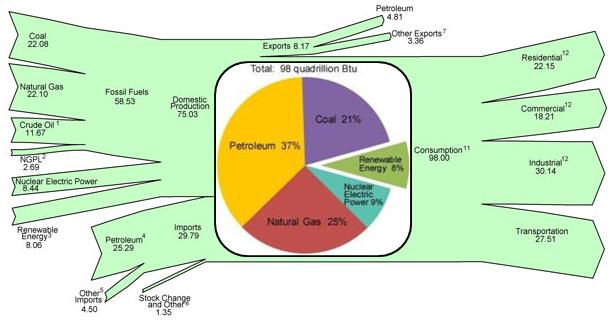
Renewable Energy as Share of Total Primary Energy Consumption, 2010
Total Energy Flow = 98 Quadrillion BTUs ~ Renewable Energy Share = 8%
Monthly Energy Review, U.S. Energy Information Administration, 23 December 2011
For a set of 43 graphs on USA energy flows 1949-2010, click here
Human willingness and technical innovation can make it possible to integrate the behavioral and technical sides of the transition puzzle. However, technological innovation alone is not likely to be sufficient. Strong economic incentivation, and significant human adaptation, will probably be required. Perhaps the most significant limit to future energy supplies is the “net energy” factor—the requirement that energy systems yield more energy than is invested in their construction and operation. More about this in the next section.
RECENT:
|
7. Integrated Strategy for the Transition to Clean Energy
This section presents the emerging synthesis of all the information in sections 1 to 7. The synthesis is presented in the form of a concept that integrates the social, economic, and energy issues that must be resolved to attain a civilized (i.e., humane) transition during the first half of the 21st century. Energy balance for entropy control is a non-negotiable requirement, and gender balance for violence mitigation is an indispensable catalyst for the transition. The strategy is presented next from the process, time-phasing, and system perspectives:
INTEGRATED TRANSITION STRATEGY - PROCESS VIEW
|
The following is a conceptual diagram of the sustainable development process:
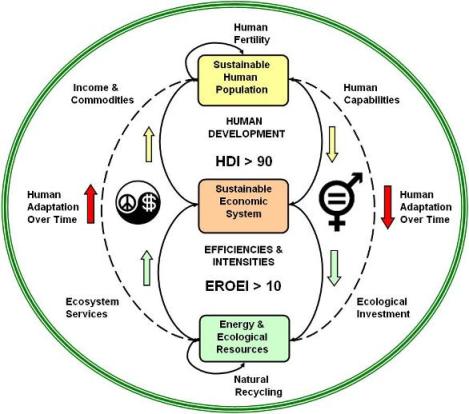
Bounded Population-Economic-Ecological System for Sustainable Human Development
Adapted from
Prosperity without Growth, Tim Jackson, 2011, Figure 12.1, Page 195
BASIC ARCHITECTURE FOR SDSIM 2.0
There are three sets of feedback loops: human development, human adaptation, and industrial mitigation. The human development loops (yellow arrows) improve gender equality and other human capabilities, and guide the allocation of income/commodities generated by the economic system. The human adaptation loops (red arrows) drive ecological investment so as to enhance the sustainability of ecosystem services. The industrial mitigation loops (green arrows) improve the productivity of energy and other resources by using "industrial engineering" methods. The working hypothesis is that mitigation loops are helpful as long as their operation is subservient to, and do not interfere with, the human development and human adaptation loops.
The convergence of gender balance, energy balance, and sustainability emerges from gender imbalance and energy imbalance jointly driving human civilization toward unsustainability. Many other factors are involved, but gender and energy imbalances are the most pervasive, and balancing them would have a neutralizing effect on all the other factors that conspire against a sustainable human society. If the transition from consumerism to sustainability is to be attained in a timely and civilized manner, i.e., before it is too late and minimizing violence as much as possible, balancing gender relations and energy flows would be the best (perhaps the only?) way to go.
INTEGRATED TRANSITION STRATEGY - PHASES VIEW
|
There are four phases: concientization, incentivation, redistribution, and democratization. Phases may overlap recursively. Time is of the esence, but the specifc start/end dates for the time windows are impossible to predict.
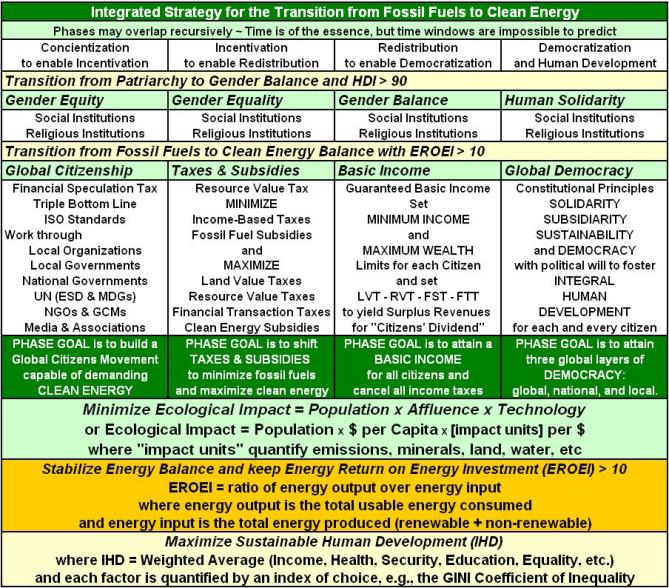
The following acronyms, and terminology are used in this transition concept and subsequent discussion:
Energy Return on Investment (EROI)
Energy return on Energy Investment (EROEI)
Financial Transaction Tax (FTT)
Global Citizens Movement (GCM)
Human Development (HD)
Human Development Index (HDI)
Human Development Report (HDR)
Integral Human Development (IHD)
International Standards Organization (ISO)
|
Land Value Tax (LVT) or Resource Value Tax (RVT)
Maslow's Hierarchy of Human Needs (MASLOW)
Non-Governmental Organization (NGO)
Principle of Solidarity (SOLIDARITY)
Principle of Subsidiarity (SUBSIDIARITY)
Principle of Sustainability (SUSTAINABILITY)
Sustainable Development (SD)
Sustainable Human Development (SHD)
Triple Bottom Line (TBL)
|
The formula I=PxAxT, known as "Ehrlich's Equation," is generally recognized as a good model for the ecological impact of economic activity. The impact is a nonlinear function of human population (P, # of persons), affluence (A) measured as consumption per capita ($/person), and a technology factor (T) that quantifies the impact (in physical units) per dollar of consumption. Note that for impact (I) to decrease, the technology factor (T) must go down faster than the product of population (P) and lifestyle (A) grows.
|
Several formulations are possible for IHD. The best known is the United Nations' Human Development Index (HDI) which includes three components: life expectancy, years of schooling, and GNP per capita. The are many variations of the HDI to include, for example, the gender equality dimension. Other indices attempt to replace GNP with other measures of human wellbeing, such as the Genuine Progress Indicator (GPI), the GINI Cofficient of Inequality, and the Happy Planet Index (HPI).
|
|
The transition entails maximizing human development and wellbeing as much as possible, and minimizing ecological impacts as much as possible, in a manner that leads to economic and ecological stability. Clearly, maximizing human wellbeing and minimizing ecological impact are mutually contradictory goals as long as human wellbeing is measured in terms of material consumption per capita. Since there are resource limits, and there are limits to efficiency improvements via technological innovation, something must give: humans must adapt by shifting expectations of wellbeing from economic affluence to other human development goals. It is impossible to predict how this adaptation process will unfold, but the following synopsis of the transition phases is proposed as a point of reference:
The first phase is concientization to enable incentivation. The objective is to create widespread popular support for the required revisions of tax codes and energy subsidies. In other words, the first phase is about creating a collective mindset of global citizenship and social responsibility, strong enough to translate into political will to face the inevitable transition and implement required reforms. Gender equity is key.
The second phase is incentivation to enable redistribution. The objective is to reform tax codes and energy subsidies to expedite the transition from fossil fuels to clean energy. Applicable reforms include shifting taxes from earned income to the usage (extraction) of unearned resources and the release of pollution, as well as taxing financial transactions of dubious social value. Gender equality is key.
The third phase is redistribution to enable democratization. The objective is to institutionalize democracy with gender balance and distributive justice. This may entail adopting a Universally Guaranteed Personal Income (i.e., a basic minimum income rather than a minimum wage) and a Maximum Allowable Personal Wealth (i.e., an upper limit on financial wealth accumulation) that can be democratically adjusted periodically.
The fourth phase is worldwide democratization. The objective is democratization of global, national, and local governance with deeply ingrained gender balance and widely institutionalized implementation of the solidarity, subsidiarity, and sustainability principles. Decisions are to be made at the lowest possible level consistent with governance capabilities and the common good of humanity.
The four phases are not envisioned to be strictly sequential. They most probably will overlap, with recursions and convulsions along the way. The term "gender equality" is not to be understood as "gender uniformity." By gender equality is meant equality of dignity and personal development opportunities across the entire gender continuum. In other words, full equality in all dimensions of human life: physical, intellectual, psychological, vocational, spiritual. The term "clean energy" is to be understood as "clean renewable energy" that is naturally replenished and does not produce GHG emissions when used. It does not include absurdities such as "clean coal." The combination of gender balance and energy balance is hereby proposed as the necessary and sufficient driver for a civilized (i.e., humane) transition, and are expected to have a multiplying effect throughout the global human system.
INTEGRATED TRANSITION STRATEGY - SYSTEM VIEW
|
SYSTEM VIEW OF THE SUSTAINABILITY PARADOX
The following diagram represents the present world human system:
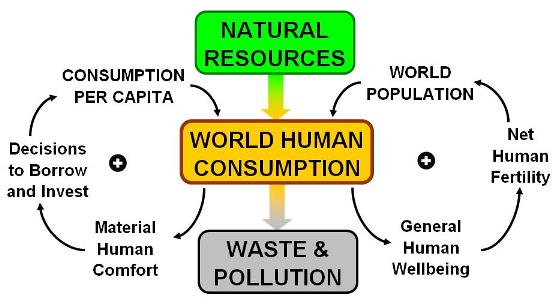
THE SUSTAINABILITY PARADOX
The positive signs indicate positive (self-reinforcing) feedback loops
Based on the Ecocosm Paradox Diagram by Willard R. Fey & Ann C. W. Lam, 1999
The downward flow at the center is the flow (lifecycle) for all kinds of merchandise. The feedback loop on the right-hand side is the population growth process. The feedback loop on the left-hand side is the economic growth process. If human consumption keeps increasing, natural resources are depleted and pollution accumulates. If human consumption decreases/stabilizes, the current economic/financial system destabilizes/collapses. This is the "infinite growth in a finite planet" paradox, which is more commonly referred to as the "sustainable development" paradox or simply the sustainability paradox.
The connecting arrows in the diagram indicate a ceteris paribus direction of influence. In the current world system the sense of every influence is positive, i.e., "more" leads to "more." However, the strength of the influence may change with time depending on various factors. For instance, the strength of the influence from "General Human Wellbeing" to "Net Human Fertility" may decrease after a certain threshold of wellbeing, higher levels of education, and accesibility to reproductive heath care. The strength of the influence from "Material Human Comfort" to "Decisions to Borrow and Invest" may increase when lines of credit with low interest rates are easy to obtain.
SYSTEM VIEW OF THE SUSTAINABILITY PARADOX
WITH SUPERIMPOSED TRENDS
The following diagram represents the present world human system with samples of recent trend data for population, consumption, and the physical flows of energy and materials:
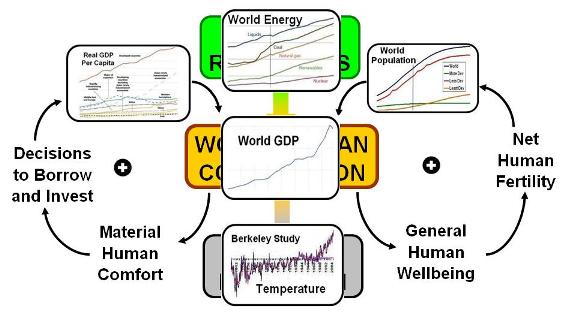
THE SUSTAINABILITY PARADOX WITH SUPERIMPOSED TRENDS
World Population 1950-2100 (UNDATA, 2010 Revision)
World Consumption Per Capita 1965-1995 (World Bank, 2011)
World Human Consumption 1960-2009 (World Bank, 2011)
World Energy Consumption 1990-2035(DOE EIA, IEO 2011)
World Average Land Surface Temperature 1800-2005 (Berkeley Earth, October 2011)
At the moment, the world's population is approximately 7 billion people but the rate of growth is slowing down. Global consumption of goods and services is approaching 60 trillion dollars, with 80% of commodities going to 20% of the population. Empirical data shows that consumption is growing faster than population, even though over one billion people remain in abject poverty. The global financial system is in total disarray. Worldwide, the rich-poor gap is increasing increasingly. Billions of tons of minerals and fossil fuels are being extracted from the earth each year, and billions of tons of waste and pollutants are being dumped back into the environment. Climate change, induced by global warming, is already impacting some human communities. Specific numbers are important, but recent growth patterns and their projected continuation are the main concern. It is impossible to predict the timing of forthcoming events, but it is reasonable to anticipate that infinite material growth in a finite planet is a mathematical impossibility.
The above hypothesis on how economic growth dynamics unfold can be refined in many different ways. For instance, the following diagram includes only the economic growth loops (left portion of the diagram) to show additional investment loops on financial credit, job creation, technology development, and advertising. Now we have a multiplicity of positive feedback loops that reinforce each other and jointly reinforce human consumption, as in the following diagram:
SYSTEM VIEW OF THE SUSTAINABILITY PARADOX
WITH MULTIPLE ECONOMIC GROWTH & JOB CREATION LOOPS
The following diagram represents the present world human system with added detail on job creation in conjunction with the economic growth process:
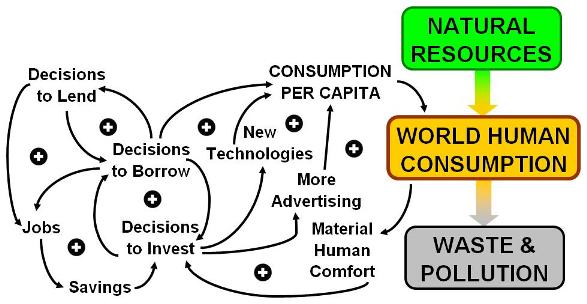
THE SUSTAINABILITY PARADOX WITH MULTIPLE ECONOMIC GROWTH & JOB CREATION LOOPS
Another way to expand the hypothesis is by including the financial growth loops whereby banks lend to industry and, in addition, lend to investors seeking financial gain for the sake of financial gain (i.e., nothing is produced or consumed). Such is the case, for example, when investor A borrows money from bank X at a given interest rate, then lends the money to investor B at a higher interest rate and pockets the additional gain. This kind of financial speculation activity (which is perfectly legal and facilitated by currencies no longer being under the gold or some other tangible resource standard) that may lead to financial bubbles and crises as happened recently in the USA and more recently in Europe. Consider the following diagram:
SYSTEM VIEW OF THE SUSTAINABILITY PARADOX
WITH MULTIPLE FINANCIAL GROWTH LOOPS
The following diagram represents the present world human system with added detail on the financial dimension of the economic growth process:
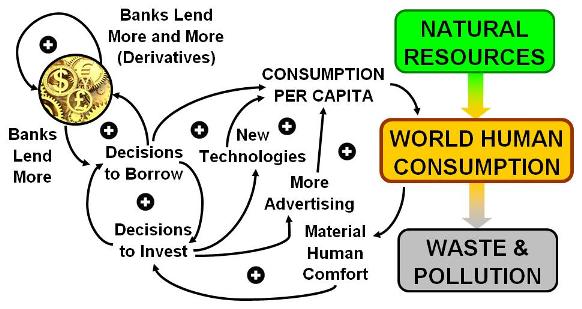
THE SUSTAINABILITY PARADOX WITH MULTIPLE FINANCIAL GROWTH LOOPS
There is empirical evidence that total world population is now increasing decreasingly, so current economic conditions suggest focusing on the economic side of the sustainability paradox. The economic growth process is driven by growing consumer demand for additional material comfort in the form of goods and services. This induces decisions to invest for expansion of industrial capacity, new technologies, and more advertising. Banks reinforce investment by lending to investors, and also by lending to consumers eager to increase their per capita consumption, which is currently growing faster than population. Since the dollar and other currencies are no longer based on gold, banks also can lend for trading in derivatives and other "financial weapons of mass destruction." This unbriddled capital accumulation process, driven by short-term profits and a systematic discounting of the future, assumes that there can be infinite growth in a finite planet, and actually requires continued and unlimited growth to keep functioning. This is the essence of the sustainability paradox.
SYSTEM VIEW OF THE SUSTAINABILITY PARADIGM
The following diagram represents the future world human system:
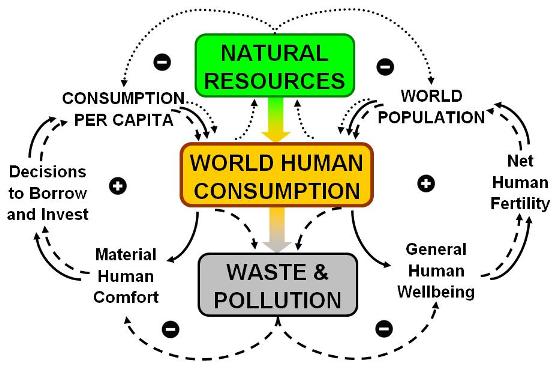
THE SUSTAINABILITY PARADIGM
The positive signs indicate positive (self-reinforcing) feedback loops
The negative signs indicate negative (self-correcting) feedback loops
The new connectors at the top linking natural resources to population and consumption per capita create adaptation loops (dotted lines). As long as natural resources are not limiting, these loops remain inactive. When one or more natural resources (e.g., minerals, water, fossil fuels) become limiting, resource prices are bound to increase and adaptation must take place by limiting population growth, economic growth, or both. On the economic side, this entails reducing consumption, substituting one resource by another, or both.
The new connectors at the bottom linking waste/pollution accumulation to human comfort (material or otherwise) are mitigation loops (dashed lines). As long as environmental degradation does not affect human comfort, these loops remain inactive. When the accumulation of pollutants is such that human well-being (material comfort, health, etc.) is impacted, the costs of environmental remediation are bound to increase and mitigation must take place by shifting priorities from comfort to survival.
SYSTEM VIEW OF THE SUSTAINABILITY PARADIGM
WITH EMBEDDED INPUT-OUTPUT MATRIX
The following diagram represents the future world human system enhanced to show the vector of resource intensities, the matrix of inter-industry transactions, and the vector of emission factors:
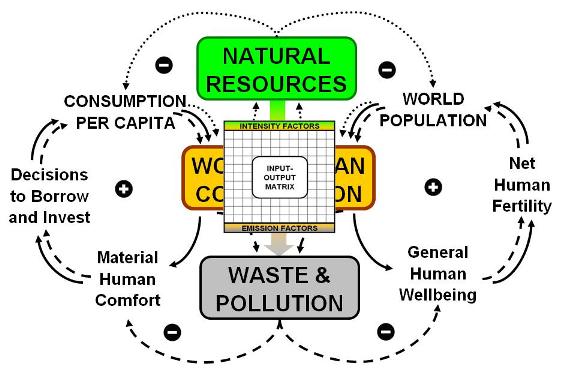
THE SUSTAINABILITY PARADIGM WITH EMBEDDED INPUT-OUTPUT MATRIX
The positive signs indicate positive (self-reinforcing) feedback loops
The negative signs indicate negative (self-correcting) feedback loops
Intensity factors are in resource input units per unit of merchandise produced
The input-output matrix is the Leontief matrix of interindustry transactions
Emission factors are in emission output units per unit of merchandise consumed
When the mitigation and adaptation loops are activated, analysis of possible trade-offs and substitutions will require an embedded inter-industry transactions matrix. How specificity of the analyzable trade-offs will be contingent on the granularity of industry decomposition captured by the input-output matrix. For instance, the North American Industry Classification System (NAICS) divides GDP into 24 major industry sectors which in turn are decomposed into a total of 2228 industries. The web-based Economic Input-Output Life Cycle Assessment (EIO-LCA) at the Green Design Institute, Carnegie Mellon University, divides GDP into 27 "broad sector groups," each further decomposed into a number of "detailed sectors." See also the System of National Accounts (SNA), United Nations, 2009.
SYSTEM VIEW OF THE SUSTAINABILITY PARADIGM WITH PROPOSED
RESOURCE VALUE TAXES (RVT) AND FINANCIAL TRANSACTION TAXES (FTT)
The following diagram represents the future world human system further enhanced to show self-correcting environmental and financial management loops:
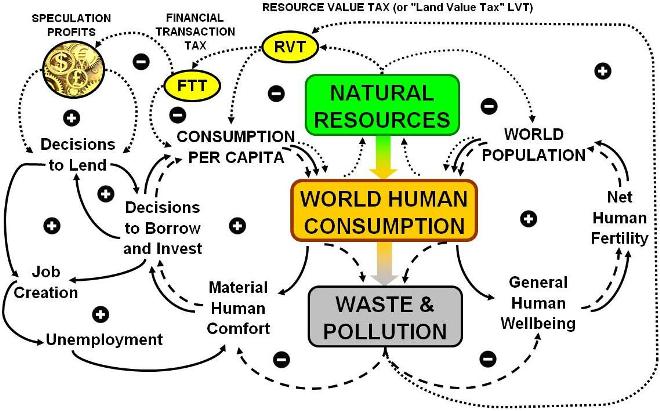
THE SUSTAINABILITY PARADIGM WITH ENVIRONMENTAL & FINANCIAL LOOPS
The positive signs indicate positive (self-reinforcing) feedback loops
The negative signs indicate negative (self-correcting) feedback loops
Resource Value Taxes (RVT) are a function of natural resource depletion/deterioration
Financial Transaction Taxes are a function of RVT and the volume of non-real financial assets
RVT and FTT serve to reinforce job creation and employment opportunities
The formulation of adaptation and mitigation policies will attempt to integrate several dimensions of scientific knowledge and human experience, including gender equality issues, in order to simulate some plausible (but by no means predictive) transition scenarios and trade-offs. For a detailed list of supporting references click here. Nothing is totally unrelated to sustainable human development, and there are many variations of any conceivable transition scenario. Some of the variations to be investigated are identified in the following section.
|
8. Variations of the Integrated Transition Strategy
PESSIMISTIC SCENARIO
Energy in Million TOE
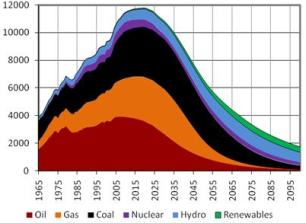
Paul Chefurka's 1965-2095 Scenario
For larger image,
see WEAP, Figure 13
|
BUSINESS AS USUAL
Energy in Quadrillion BTU
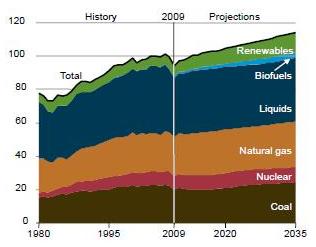
EIA's 1980-2035 Scenario
For larger image, see
EIA, Page 63
|
OPTIMISTIC SCENARIO
Energy in MB/D OTE
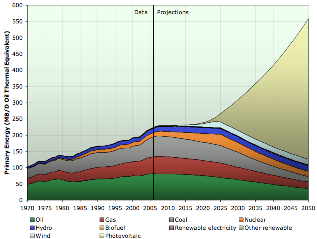
Stuart Staniford's 1970-2050 Scenario
For larger image, see The Oil Drum, Post 3540
|
In terms of the transition from fossil fuels to clean energy, there seems to be a convergence of outlook that is shared by business, agencies, and NGOs. This convergence is reflected in the EIA (business as usual) scenario. However, in terms off replacing fossil fuels with clean energy is a post-carbon world, the Paul Chefurka's scenario is the most pessimistic and Stuart Staniford's scenario is the most optimistic . Actually, it is not a matter of being optimistic or pessimistic. The divergence between "best case" and "worst case" scenarios may be due different sets of explicit assumptions about the timing of supply peaks for non-renewables and ramping up capacities for renewables plus different sets of implicit assumptions about human behavior and policy decisions in the context of an exceedingly complex system. Energy in some form is behind everything that moves, and there are many moving parts in industrial economies.
In their recently published book, Energy and the Wealth of Nations, Hall and Klitgaard point out that discrediting economic theories that have served us well in the past serves no purpose. It is not a matter of choosing between classical economics, or neoliberal economics, or behavioral economics, or ecological economics, or biophysical economics. But, as they also point out, it is the separation of the biophysical and social dimensions of economics that renders either one useless in confronting newly emerging issues at the intersection of human behavior and physical flows. In every case, however, energy flows are the point of intersection between the behavioral and the physical dimensions, and it could well be that "economic energetics" is the key for integrating both and developing a new synthesis, as proposed long ago by (among others) economist Nicholas Georgescu-Roegen and ecologist Howard T. Odum. In this regard, the "ecological economics" synthesis of Herman Daly deserves especial mention. Hall & Klitgaard's contribution is to isolate energy flows as the focal point for analysis (and hypothesis testing) via the "Energy Return on Investment" (EROI) index.
For the current level of climate change mitigation technologies, it would seem that Staniford's scenario is too optimistic in assuming that the production of fossil fuels can be sustained and the planet can absorb the resulting accumulation of GHG emissions without potentially catastrophic climate disruptions. On the other hand, Chefurka's scenario may be too pessimistic and hopefully will not come pass as the human-impact implications would be severe. EIA's scenario seems to be the most plausible with current technologies and economic conditions. However, the emergence of radically new and economically feasible technologies cannot be ruled out, and there is always the need to plan for the worst case scenario. With this range of scenarios in mind, the following variations are being considered for modeling and analysis:
- Variations in the timing and duration of human adaptations
- Variations in the human propensity to consume (volume, choices, fix vs replace
- Variations in the human propensity to adapt (climate, migration, transportation)
- Variations in the pace of progress in secular gender equity, equality, and balance
- Variations in the pace of progress in religious gender equity, equality, and balance
- Variations in the adaptability of the world financial system (speculation, regulation)
- Variations in the resilience of the human habitat (pollution, climate, ecosystem services)
- Variations in fossil fuel reserves and the timing of "peak oil"
- Variations in the timing and intensity of climate changes
- Variations in the performance, schedule, and cost of clean energy technologies
- Variations in the EROI values of non-renewable and renewable energy sources
- Variations in the EROI values for resource discovery
- Variations in the EROI values for resource development
- Variations in the EROI values for resource extraction
- Variations in the EROI values for resource conversion during production
- Variations in the EROI values for resource conversion during consumption
- Variations in the EROI values for resource conversion during disposal
- Variations in the EROI values for resource emissions during production
- Variations in the EROI values for resource emissions during consumption
- Variations in the EROI values for resource emissions during disposal
Given the complexity and nonlinearity of complex ecological-economic systems, computer simulation methods are more promising for the analysis of dynamic modes of behavior related to both the "sustainability paradox" and the "sustainability paradigm" systems are diagrammed above. However, input-output analysis could be very useful to calculate specific interindustry propagations of energy resource substitutions within paradox/paradigm scenarios.
EDITOR'S NOTE: These variations are to be formulated and explored with SDSIM 2.0 (to view SDSIM 1.5, click here).
|
9. Strategic Data Sources & Global Transition Megatrends
|
Listed below are links to the best data and knowledge sources in two categories: strategic data sources and global transition megatrends.
KEY LINKS:
- STRATEGIC DATA SOURCES
- UNFCCC Technology Information System, UNFCCC Presentation, 2002.
- Great Transition Initiative (GTI) Scenarios and Database, GTI, 2007.
- Maps and Graphics Library, UNEP/Arindal, 2008.
- World Income Inequality Database, WIID, UNU-WIDER, 2008.
-
Shell Energy Scenarios 2000-2050, Shell International BV, 2008.
- Human Development Index (HDI) Database, UNDP, 2010.
- 2010 World Population Data Sheet, PRB, 2010.
- Policies and Measures Databases, UN International Energy Agency (IEA), 2011.
- Energy Research Guide and Database, US Energy Information Agency (EIA), 2011.
- Energy Outlook 2030, BP, 2011.
- Statistical Review of World Energy 2011, BP, 2011.
- 100% Renewable Energy by 2050, WWF, 2011.
- IMF Financial Databases, IMF, 2011.
- World Income Inequality Database (WIID)
- 2011 World Population Data Sheet, PRB, 2011.
- Gender, Institutions and Development Data Base (GID-DB), OECD, 2011.
- USA Federal Government Databases (DATA), US Government, 2011.
- United Nations Database (UNData), United Nations, 2011.
- International Energy Outlook 2011, US DOE/EIA, September 2011.
- World Energy Insight 2011, World Energy Council, September 2011.
- Global Megatrends Factsheet, German Advisory Council on Global Change (WBGU), October 2011.
- World Energy Outlook 2011, IEA, 9 November 2011.
- IEA sees a world run on solar, Giles Parkinson, Climate Spectator, 6 December 2011.
- Oil Market Report, IEA, 13 December 2011.
- Ireland plots path to a sustainable energy future, IEA/SEAI, 22 December 2011.
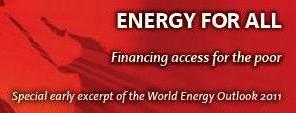
|

|
|
From the IEA WEO 2011 web site:
"The 2011 edition of the World Energy Outlook was released on 9 November and brings together the latest data, policy developments, and the experience of another year to provide robust analysis and insight into global energy markets, today and for the next 25 years. This edition of the IEA's flagship WEO publication gives the latest energy demand and supply projections for different future scenarios, broken down by country, fuel and sector.
"It also gives special focus to such topical energy sector issues as Russia’s energy prospects and their implications for global markets; the role of coal in driving economic growth in an emissions-constrained world; how high-carbon infrastructure "lock-in" is making the 2°C climate change goal more challenging and expensive to meet; the scale of fossil fuel subsidies and support for renewable energy and their impact on energy, economic and environmental trends; or the scale and type of investment needed to provide modern energy to the billions of the world’s poor that do not have it.
"WEO-2011 further analyses some of the most pressing issues faced by the energy world this year by looking at the implications of a possible delay in oil and gas sector investment in the Middle East and North Africa and also by presenting a "Low Nuclear Case" to investigate what a rapid slowdown in the use of nuclear power would mean for the global energy landscape."
|
- GLOBAL TRANSITION MEGATRENDS
The precision and accuracy of the data sources listed above span the entire spectrum from "very soft" to "somewhat credible." The visible megatrends are highly aggregated and therefore less sensitive to data collection inadequacies. Still invisible is the most critical megatrend toward gender equality/gender balance in roles of responsibility and authority. Already visible, however, is the global warming trend induced by the patriarchal mindset of exploiting and subduing nature:
Sea Levels May Rise Faster Than Expected, Sam Eaton, The World, 6 December 2011
|
|
|Back to the SUMMARY|
|Back to SECTION 1|
|Back to SECTION 2|
|Back to SECTION 3|
|Back to SECTION 4|
|Back to SECTION 5|
|Back to SECTION 6|
|Back to SECTION 7|
|Back to SECTION 8|
|Back to SECTION 9|
Page 1
Page 2
Page 3
Page 4
Page 5
Page 6
Page 7
Page 8
Page 9
Supplement 1
Supplement 2
Supplement 3
Supplement 4
Supplement 5
Supplement 6
PelicanWeb Home Page
|
|
"The profit from the Earth is for all."
Ecclesiastes 5:9
|
|
Supplement 3
|
|
FREE SUBSCRIPTION
|
![[groups_small]](groups_small.gif)
|
Subscribe to the
Mother Pelican Journal
via the Solidarity-Sustainability Group
Enter your email address:
|
|
|
|